Genomic Science Has Come a Long Way in 70 Years
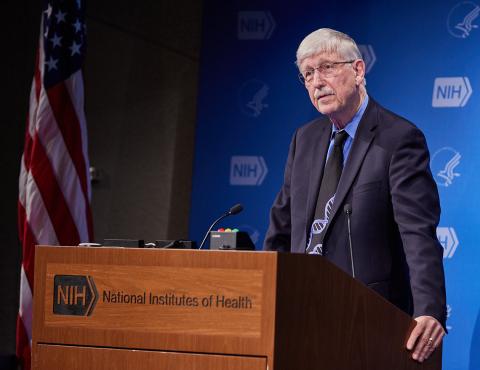
Photo: Ernesto Del Aguila
Scientists have made great advances in genomics since the discovery of the DNA double helix 70 years ago, said Dr. Francis Collins during the recent Louise M. Slaughter National DNA Day lecture.
“This is the most exciting time you can imagine in biomedical research and genomics, because of the potential to transform medicine,” said Collins, former NIH and NHGRI director and advisor to President Biden for special projects.
Collins’s lecture concluded NHGRI’s National DNA Day 20th anniversary symposium, which was held in Lipsett Amphitheater on Apr. 25. The event commemorated two milestones: the 20th anniversary of the Human Genome Project’s completion and the 70th anniversary of the discovery of the DNA double helix.
The day featured panel discussions about the evolution and future of genomics research, greater impacts of genomics on society and the wide array of careers in genetics and genomics as well as a friendly competition to determine who is the Greatest of All Time (GOAT) NHGRI director.
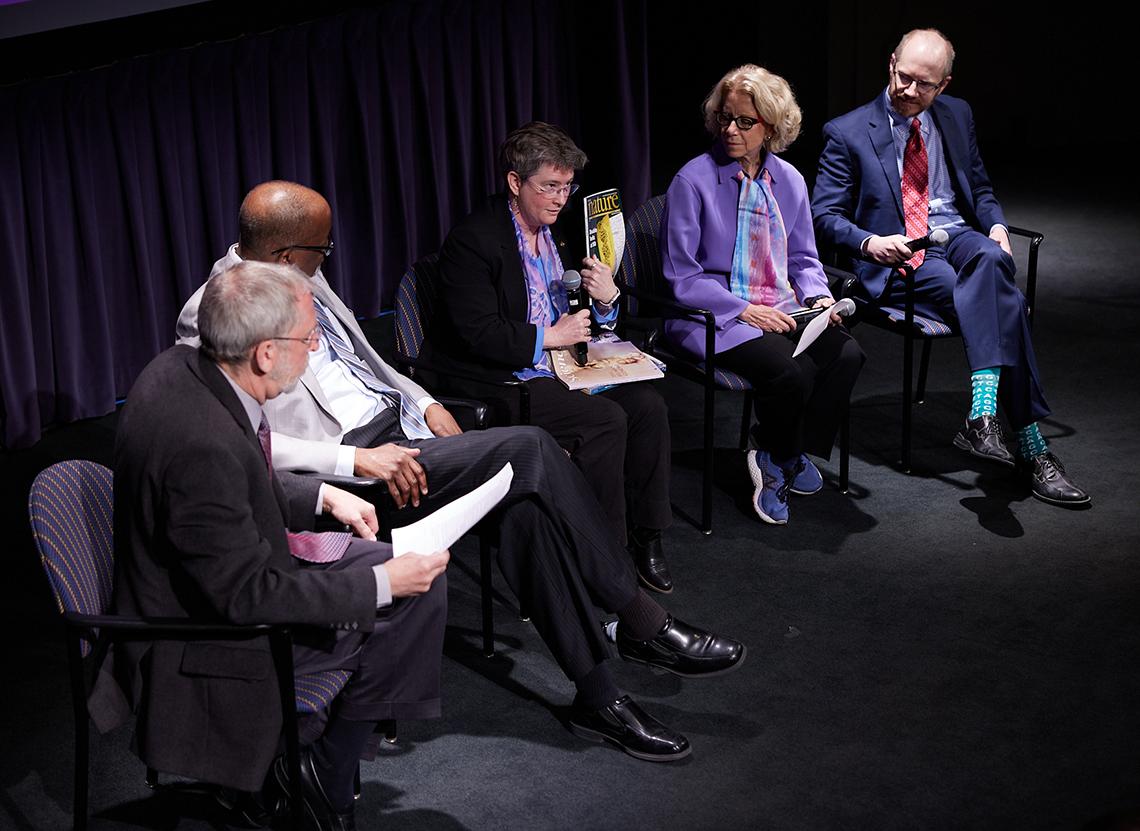
Photo: Ernesto Del Aguila
On Apr. 25, 1953, Dr. James Watson and Dr. Francis Crick published an article in Nature revealing their discovery of DNA’s physical structure. The DNA molecule resembled a ladder twisted in a helix-like shape. Their ability to put together the structure depended on experimental data produced by Dr. Rosalind Franklin, an X-ray crystallographer.
Her photo—known as “Photograph 51”—helped scientists learn more about DNA’s three-dimensional structure. She passed away before Watson and Crick were awarded the Nobel Prize for their discovery.
“Whenever we talk about DNA, I think about Rosalind,” Collins said, who now works as a senior investigator in NHGRI’s Center for Precision Health Research and heads its molecular genetics section.
In the decades after their discovery, scientists began to track down the genetic causes of diseases. Without today’s computational power and access to a reference human genome sequence, they had a really hard time.

Photo: Ernesto Del Aguila
In the 1980s, for instance, it took Collins and a team of scientists seven years to discover the genetic mutation that causes cystic fibrosis. Finding the gene was like “looking for a needle in a haystack.” Today, by comparison, a graduate student with the right technology and family DNA samples could complete the task in a week.
Researchers could not take the same arduous approach for the thousands of other diseases that are even more rare than cystic fibrosis. “We had to have a better plan,” Collins noted.
In 1988, a National Academy of Sciences special committee released a report that provided a blueprint for mapping and sequencing the human genome. The document recommended short- and long-range goals for an effort that became known as the Human Genome Project (HGP). Over the course of the project, more than 2,400 scientists from six countries participated in the effort.
Before attempting to sequence the human genome, the committee suggested that scientists sequence other genomes of model organisms that aren’t as big, such as bacteria, yeast and roundworm. Building up capability and inventing better technology piqued the interest of many investigators.
Three years after the project officially began, Collins joined NIH to manage the HGP. “It has been a wild ride,” he said. “During the first few years we worked on those model organisms, we also worked on building maps—both physical maps and genetic maps—of the human genome.”
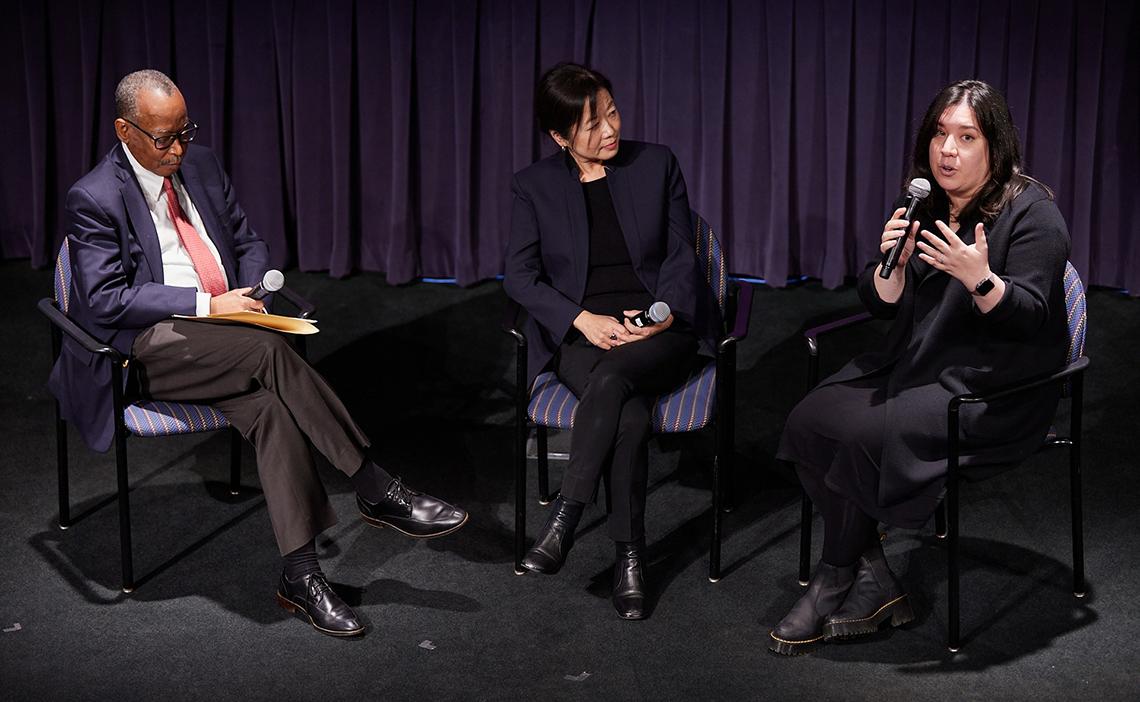
Photo: Ernesto Del Aguila
By 1996, the project was beginning to sequence human DNA. Those involved had to decide what to do with it. They agreed to the “Bermuda Principles,” which required that data be publicly available within 24 hours of having been error-checked.
“If you’re going to do a large, complicated community-beneficial project, then the community needs to benefit by having rapid access to the data,” Collins noted. “This has now become the norm for genomic science.”
In the years since, other large-scale genomic projects have followed the example HGP set: bring scientists together, let them work on difficult problems and make data publicly available as quickly as possible.
In June 2000, a first draft of the human genome was announced at the White House. On Apr. 25, 2003, all of the goals of the HGP were successfully completed. An amazing group of scientists worked hard to accomplish the feat, Collins said. They rolled up their sleeves and devised many creative solutions over the years.
“I will always be grateful to the scientists and for the opportunity to have served as the director of the International Human Genome Sequencing Consortium,” he noted.
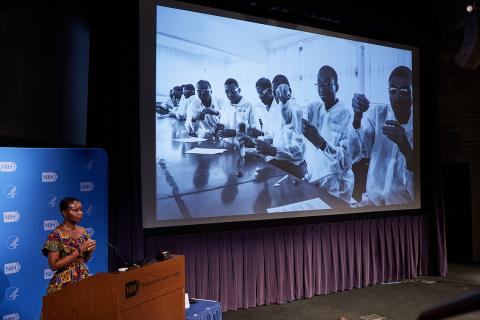
Photo: Ernesto Del Aguila
The HGP also invested in efforts to anticipate and prepare for ethical issues that might arise from the knowledge of our own DNA instruction book. An early concern was genetic discrimination: Once genetic information became more accessible, employers and health insurance companies could use that data against people.
After 12 years working with Congress, the Genetic Information Nondiscrimination Act became law in 2008. It protects individuals from employment and health insurance discrimination based on their DNA. U.S. Congresswoman Slaughter, for whom the lecture is named, was the leading advocate for the legislative protections.
“This was a really big deal,” Collins said. “This is not to say that we’ve fully addressed all of the issues with genetic discrimination—because they are still out there and there are even threats to this particular law by employers.”
Another critical issue addressed by the ELSI (ethical, legal and social issues) program of the HGP, and continuing to be a high priority for NHGRI, is the relationship between race and genomics. Based on a recent National Academies of Sciences, Engineering and Medicine report, researchers must rethink and justify how they use race, ethnicity and ancestry as population descriptors in genomics and biomedical research. They need to state the rationale behind what classification systems or group labels they use in their research.
New lab tools, computational methods and strategic approaches have allowed scientists to build upon the work of the HGP. Last year, for example, the Telomere to Telomere (T2T) consortium published the first complete, gapless sequence of a human genome.
Genomic technology has had many other profound consequences. For example, scientists can now ask individual cells what genes are expressed and which parts of chromatin are open for business.
“If you want to understand life, you need to understand cells,” Collins said. “Until recently, we haven’t been able to ask one cell, ‘Hey, what are you doing?’ We can now do that.”
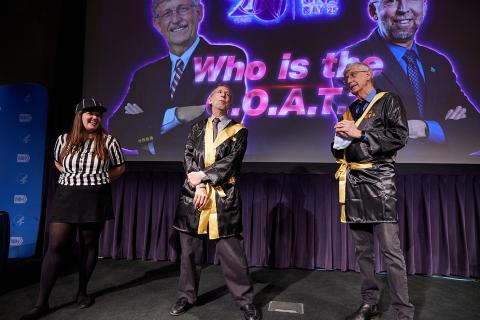
Photo: Ernesto Del Aguila
The consequences for disease gene discovery have been profound. In 1990, there were only 68 rare diseases with a known molecular basis, Collins said. Researchers now know the molecular basis of 6,800 rare diseases. Unfortunately, however, only about 500 such disorders have an FDA-approved treatment. There is a huge gap between diagnostic and therapeutic ability. Technologies such as gene editing are beginning to offer hope to these patients. However, much work lies ahead.
The future of genome research is profoundly promising, but these advances won’t happen without “the people to make it happen,” Collins concluded. “This future requires a vibrant and diverse genomics workforce.”
The annual Slaughter lecture honors the life and legacy of the late New York legislator, who was a strong advocate for genomics research. She was also responsible for passing the 2003 resolution in the U.S. House of Representatives that created National DNA Day. NHGRI established the lecture in her name in 2018.
A recording of the symposium is available at https://go.nih.gov/IYkk2XV.
